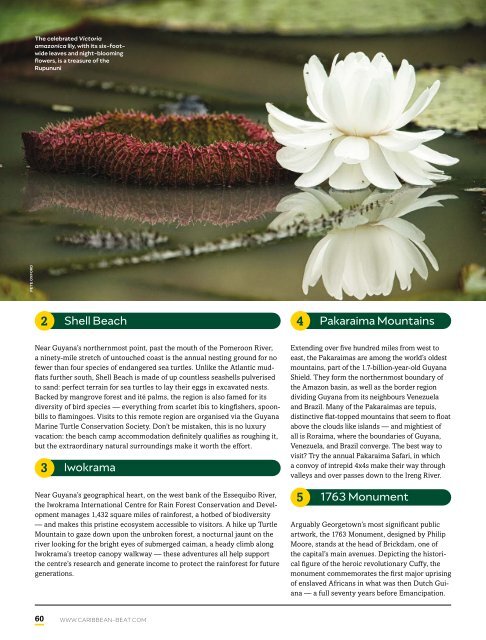Caribbean Beat — September/October 2018 (#153)
A calendar of events; music, film, and book reviews; travel features; people profiles, and much more.
A calendar of events; music, film, and book reviews; travel features; people profiles, and much more.
Create successful ePaper yourself
Turn your PDF publications into a flip-book with our unique Google optimized e-Paper software.
The celebrated Victoria<br />
amazonica lily, with its six-footwide<br />
leaves and night-blooming<br />
flowers, is a treasure of the<br />
Rupununi<br />
pete oxford<br />
2 Shell Beach<br />
4 Pakaraima Mountains<br />
Near Guyana’s northernmost point, past the mouth of the Pomeroon River,<br />
a ninety-mile stretch of untouched coast is the annual nesting ground for no<br />
fewer than four species of endangered sea turtles. Unlike the Atlantic mudflats<br />
further south, Shell Beach is made of up countless seashells pulverised<br />
to sand: perfect terrain for sea turtles to lay their eggs in excavated nests.<br />
Backed by mangrove forest and ité palms, the region is also famed for its<br />
diversity of bird species <strong>—</strong> everything from scarlet ibis to kingfishers, spoonbills<br />
to flamingoes. Visits to this remote region are organised via the Guyana<br />
Marine Turtle Conservation Society. Don’t be mistaken, this is no luxury<br />
vacation: the beach camp accommodation definitely qualifies as roughing it,<br />
but the extraordinary natural surroundings make it worth the effort.<br />
3 Iwokrama<br />
Near Guyana’s geographical heart, on the west bank of the Essequibo River,<br />
the Iwokrama International Centre for Rain Forest Conservation and Development<br />
manages 1,432 square miles of rainforest, a hotbed of biodiversity<br />
<strong>—</strong> and makes this pristine ecosystem accessible to visitors. A hike up Turtle<br />
Mountain to gaze down upon the unbroken forest, a nocturnal jaunt on the<br />
river looking for the bright eyes of submerged caiman, a heady climb along<br />
Iwokrama’s treetop canopy walkway <strong>—</strong> these adventures all help support<br />
the centre’s research and generate income to protect the rainforest for future<br />
generations.<br />
Extending over five hundred miles from west to<br />
east, the Pakaraimas are among the world’s oldest<br />
mountains, part of the 1.7-billion-year-old Guyana<br />
Shield. They form the northernmost boundary of<br />
the Amazon basin, as well as the border region<br />
dividing Guyana from its neighbours Venezuela<br />
and Brazil. Many of the Pakaraimas are tepuis,<br />
distinctive flat-topped mountains that seem to float<br />
above the clouds like islands <strong>—</strong> and mightiest of<br />
all is Roraima, where the boundaries of Guyana,<br />
Venezuela, and Brazil converge. The best way to<br />
visit? Try the annual Pakaraima Safari, in which<br />
a convoy of intrepid 4x4s make their way through<br />
valleys and over passes down to the Ireng River.<br />
5 1763 Monument<br />
Arguably Georgetown’s most significant public<br />
artwork, the 1763 Monument, designed by Philip<br />
Moore, stands at the head of Brickdam, one of<br />
the capital’s main avenues. Depicting the historical<br />
figure of the heroic revolutionary Cuffy, the<br />
monument commemorates the first major uprising<br />
of enslaved Africans in what was then Dutch Guiana<br />
<strong>—</strong> a full seventy years before Emancipation.<br />
60 WWW.CARIBBEAN-BEAT.COM


















